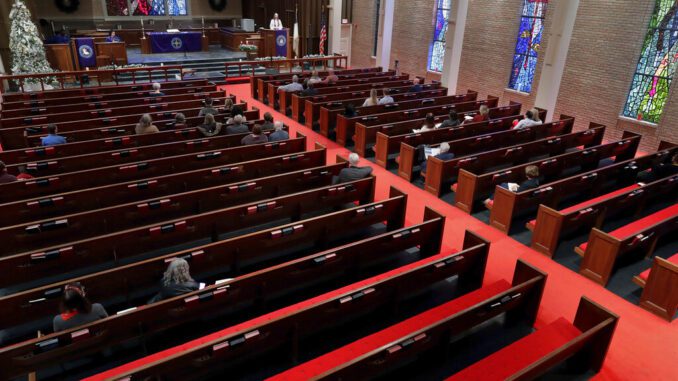
When Westminster United Methodist Church in Houston resumed in-person services late last year, after a seven-month halt due to COVID-19, there were Sundays when only three worshippers showed up, according to the pastor, Meredith Mills.
Since then, attendance has inched back up, but it’s still only about half the pre-pandemic turnout of 160 or 170, Mills estimates.
“It’s frustrating,” she said. “People just seem to want to leave home less these days.”
Some houses of worship are faring better than Mills’ church, some worse. Polls by The Associated Press-NORC Center for Public Affairs Research shows how dramatically church attendance fell during the worst of the pandemic last year, even as many say they are now returning to regular service attendance.
Among mainline Protestants, just 1% said in a May 2020 poll that they were attending in-person services at least once a week. In the new poll, 14% say they’re doing so now, compared to 16% who say they did in 2019.
Among evangelical Protestants, 37% now say they are attending services in person at least weekly, while 42% said they did that in 2019. In the May 2020 poll, just 11% said they were attending services in person that often.
Among Catholics, 26% attend in person at least weekly now, compared with 30% in 2019. In the 2020 poll, conducted as many bishops temporarily waived the obligation for weekly Mass attendance, just 5% were worshipping in person at least weekly.
Elsewhere, churches large and small have taken hits in attendance.
John Elkins, teaching pastor at Sovereign Grace Fellowship in Brazoria, Texas, says 25 to 30 people have attended services recently, down from around 50 before the pandemic.
“For some, I was not political enough,” he said via email. “Some wanted more activities, some just stopped going to church.”
Sovereign Grace, a Southern Baptist church, had never offered online worship before the pandemic. When in-person worship was halted for a month in 2020, leaving online worship as the only option, Elkins said he did more crisis counseling for congregation members than ever before.
At the much larger First Church of God in Columbus, Ohio, there was a near-total halt to in-person worship between March 2020 and September of this year. On two Sundays in September 2020, worshippers were invited back to the church to test the feasibility of in-person services.
“But it was obvious they were still uncomfortable — they came dressed like they were working at Chernobyl,” said the senior pastor, Bishop Timothy Clarke, evoking hazmat suits appropriate for confronting a nuclear disaster.
Pre-pandemic, the predominantly African American church held three services each weekend, including one on Saturday evenings, with average total attendance of 2,500. Now there’s a single service on Sunday, and only 500 worshippers — with masks and proof of vaccination — are allowed into a sanctuary that can seat more than 1,500.
The return to in-person worship “gives us a sense of connection and community,” Clarke said. “But you also have safety.”
Friendswood United Methodist Church, in the Houston suburbs, has endured not only COVID-19 disruptions but also flooding during a winter storm last February that rendered the sanctuary unusable. It just reopened for services this month, said the pastor, Jim Bass.
Pre-pandemic, Friendswood’s Sunday services would draw about 900 worshippers; Bass was pleased that about 650 gathered when the sanctuary reopened for high-energy, music-filled services on Dec. 5.
However, he said average attendance has been only half of that during most of the pandemic, creating a $400,000 shortfall in expected giving.
Like many houses of worship, Friendswood offered online services as an alternative to in-person attendance. He considers them a mixed blessing — a plus for elderly congregation members worried about their health, but a disincentive for others who are increasingly disconnected from the church.
“They’ve become spectators,” Bass said.
At Temple Beth El in Charlotte, Rabbi Asher Knight was elated that recent Hannukah celebrations drew about 300 people in person. Overall, attendance now is roughly half of pre-pandemic levels, but an improvement over periods earlier this year when only a handful of worshippers appeared.
“It was demoralizing and painful to lead worship with virtually no one present,” he said. “But in October and November, people got the booster and their children got vaccinated and they slowly started coming back.”
Among Christians, the option of worshipping online has been embraced by many evangelical Protestants, according to the AP-NORC poll. About 3 in 10 have livestreamed services at least weekly in recent months, compared with about 1 in 10 Catholics or mainline Protestants.
Roughly a quarter of evangelical Protestants say they’ve recently talked by phone or video conference with a religious or spiritual leader at least a few times a month, compared with about 1 in 10 mainline Protestants and Catholics.
Some faith leaders, such as Meredith Mills, see some positives, such as more energy in the church, even with fewer worshippers.
“The ones showing up right now are the people who really want to be there,” she said. “There’s a lot of joy in the room Sunday mornings. It’s one of the reasons that, despite everything, I still love my job.”




